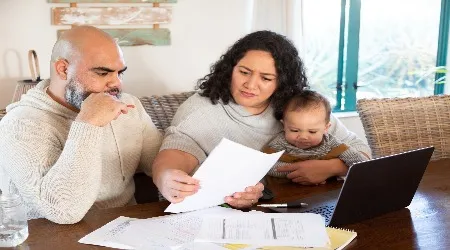
Peer to peer (P2P) investing in Australia
Enjoy returns of over 7% p.a. after fees by investing in P2P lending.
We’re reader-supported and may be paid when you visit links to partner sites. We don’t compare all products in the market, but we’re working on it!
Peer to peer (P2P) lending platforms help to link everyday borrowers with investors without getting the banks involved. While borrowers sign up to receive loans, investors become lenders in order to receive a higher return than what they'd normally get from savings accounts, term deposits and other investments.
Here are some of the main benefits of P2P investing:
- Investors can get higher returns than they could elsewhere along with a great deal of flexibility and choice. Some P2P lenders claim that investors are making as much as 12% p.a., compared to around 3% with safer options. The downside is that investors take on a higher level of risk and there's no guarantee of a return.
- Borrowers can get lower-interest loans, or avoid some of the more onerous requirements that banks or traditional lenders might place on them.
Searching for a P2P loan instead? Read our comprehensive P2P lending guide.
Invest with a peer to peer lender
Disclaimer: Investments made through a P2P lending platform are not protected and are subject to risks including credit risk (defaults) and liquidity risk. These investments are not subject to review by the Australian Financial Complaints Authority. Actual returns may vary from the Expected Returns declared by the Providers. Read the PDS for details before investing and consider your own circumstances, or get advice, before investing.
How does P2P investing work?
As an investor, your money forms part of a loan which is offered to borrowers, and your returns come from loan repayments plus the interest charged. A single loan is typically made up of money from many investors to help diversify portfolios and reduce the risk of borrower default.
Conversely, some P2P lenders let you loan out larger amounts to an individual borrower or put up the entire amount for a single loan if you think you can get a larger return on investment that way.
P2P lenders usually offer a number of different investment options, with various estimated interest rates, risk levels and loan terms from a few weeks to several years. You may also have the option of investing in different types of loans, and understanding them is an important part of P2P investing.
While borrowers are required to be pre-screened for financial stability and loan repayment ability, the possibility that you will either get no return or even lose money makes this a riskier option than keeping your money in a term deposit or savings account.
How do I choose a P2P lender to invest in?
There are a variety of peer to peer investment sites to choose from, offering a diverse range of features for investors. You'll want to take note of the operator's minimum investment, which can range from $10 to $500,000, the historical interest rate, investment term and the risk level. You can pick one with benefits that suits your needs.
Potential advantages
- High returns. The biggest draw card is the potential to earn a higher return on your investment than you might with other banking products, such as term deposits or savings accounts.
- Diversify risk. You can lend small amounts across a broad portfolio of loans and diversify your risk if you choose.
- Risk and reward control. If you're willing to take on the additional risk, you may have the ability to invest a large amount into a single loan or a business if you believe you can get a higher return.
- Streamlined. Many P2P sites have made it very simple to invest by handling the paperwork, legal documentation and credit records as well as automated monitoring of loans in your portfolio.
- Security. P2Ps operating in Australia are required to hold Australian financial services licences (AFSL) (always check first) – it means they're legally obliged to lend responsibly and conduct safety and security checks on borrowers.
- Access to a variety of options. Investors usually get a broad range of options to suit your personal appetite for risk and financial goals, including secured and unsecured loans, and different repayment terms.
Potential downsides
- No return. Despite the advertised interest rate, there is no guarantee that you will actually get any return on your investment.
- You could lose money. Some or all of your investment may be unrecoverable in the event of borrower default, even if the provider offers a guarantee.
- Loan terms. Investing in multiple loans of varying lengths can make it difficult to track and predict your returns.
- Economic downturns. Although it might seem like a term deposit, your returns could be dramatically affected by economic downturns in the future.
- Interest rate rise. An increase in interest rates means you might be committed to an under-performing investment.
- Interest rate fall. Dropping interest rates means a loan might be repaid ahead of time, reducing anticipated returns.
- Credit ratings are inconsistent. The credit ratings given by the P2P operator to loans may be misleading because there's no standard across operators or external rating agencies. You should check how they assess ratings.
What are the biggest risks of P2P investing?
- Borrower default or late payment
This is one of the biggest risks posed to investors. If a borrower doesn’t repay their loan, it means the investing lenders’ capital is at risk. If a loan cannot be repaid, the amount you may be able to recover depends on the type of loan. Some P2P borrowing sites may offer certain protections for investors in the event of this occurring.
- Interest rate risk
As with any fixed term loan or bank term deposit, there's some risk of interest rates rising before the term finishes, which means you can't move your capital into a higher-interest-bearing loan until its maturity. While this is not necessarily a risk to your capital and interest, it’s an issue that you should consider before committing your funds.
Can peer to peer operators protect you?
It's important to remember that although peer to peer operators are required to follow certain rules to better protect customers, there's never a guarantee that your money is safe.
At a minimal level, peer to peer operators in Australia are required by ASIC to conduct background checks on all borrowers before offering them a loan. This may include checking bank statements and government verification services.
However, some operators, such as Plenti, have additional securities in places, such as a protection fund which is used to compensate investors. In the case of Plenti, part of the interest charged to borrowers is transferred to its Provision Fund, while riskier borrowers will pay a higher fee which also goes into the fund. If borrowers default, investors will be compensated for all or some of their losses. Of course, an investor could still lose money in the case of heavy losses, but the impact will be minimised.
Peer to peer investing checklist
Prior to investing, you need to check with the Australian Securities & Investments Commission (ASIC) to see if the P2P platform holds an AFSL.
Know what you are investing in, and read the product disclosure statement (PDS) and Financial Services Guide (FSG) first where relevant. Look for information about:
- Security: Look at the loan's security status and determine if it is unsecured or secured.
- Minimum investment: The minimum amount you can invest ranges from around $10 to over $500,000 depending on which operator you choose.
- Interest rate: Who calculates the interest rate and what factors determine the rate?
- Choice of loans: Are you able to choose who you borrow from or lend to? Can your investment be spread over multiple loans? (This may reduce the risk of losing all your money.)
- Repayments: When will you start to reap the benefits?
- Getting your money back: Do you have the flexibility to change your mind and still retain cooling off rights? If you pull out, can you get your money back? What would you do if the borrower pulls out? What steps will the company take to recover your investment?
- What if the platform fails?: Be prepared in all scenarios. If the company does go under, do you know the steps you'll take to recover your money?
- Fees: You need to know if any fees go to the operator of the platform and if fees exist for investments and repayments.
How do I apply for peer to peer investing?
Like all providers that offer consumer loans, P2P platforms must lend responsibly to ensure the investor doesn't lose money. As an investor, you should conduct your due diligence before signing up and compare different options to find the right one for your needs.
Depending on your area of expertise, you might choose to invest mostly in business loans, mostly in personal loans, or across both.
If you want to be more discerning, you can even focus specifically on borrowers you believe have a smart business plan and a bright future, and invest similarly to how you would with a share trading account.
Investments made through a P2P lending platform are not protected and are subject to risks including credit risk (defaults) and liquidity risk. These investments are not subject to review by the Australian Financial Complaints Authority. Actual returns may vary from the Expected Returns declared by the Providers. Read the PDS for details before investing and consider your own circumstances, or get advice, before investing.
The latest news in investments


From $10K debt to $50K saved: How I fixed my finances in 4 years
How Eliza paid down her debt, cut up her credit card, saved $50,000 and started investing in a few short years (all while renting in Sydney!).
Read more…
How to get Virgin Money’s new 1.50% p.a. bonus savings account rate
The Virgin Money Boost Saver account is offering a new bonus rate of 1.50% p.a. for a limited time only. Here's how to get it, and how this offer compares.
Read more…
Pocket pay-raise: Aussie kids receiving $2 billion in allowance each year
Children are cashing in on their parents' earnings, according to new research from Finder.
Read more…
Up Bank sold for $116m: What this means for customers
Bendigo Bank has bought digital bank Up, but there's no immediate impact on Up's 400,000 customers at this stage.
Read more…
Budgeting for bubs: 10% of Australian parents had no savings before starting a family
A substantial number of Australians are starting parenthood without a healthy savings fund, according to new research by Finder.
Read more…More guides on Finder
-
Apartment Insurance
If you’re looking for home insurance for an apartment, here’s the ultimate guide to finding comprehensive and affordable cover.
-
NFT Marketplaces Review and Guide
An all-encompassing guide on NFT marketplaces. Learn how to sell, buy and create your own NFTs on the world's most popular marketplaces.
-
Disposable income in Australia
Finder analysed earnings and living expenses to find out where Aussies have the most disposable income and where is the best place to retire.
-
Find the best investment newsletters in Australia
Read our guide to the best investment newsletters to help you boost your investment knowledge and grow your wealth.
-
10 costs you don’t even know about until you buy a home
When I bought my first house, I cried, because I didn't know about stamp duty, one of many costs you don't learn about until you buy a home.
-
How to stake Cardano (ADA)
Earn interest on idle ADA tokens by staking within the Cardano blockchain.
-
First Home Buyer’s e-Course Module 1
First home buyers, kick off your journey to home ownership! To take your first step, it starts with you: what is your situation right now?
-
How to stake Chainlink (LINK)
Learn how to stake Chainlink (LINK) tokens and earn rewards through exchanges, lending services and node operation on the Chainlink network.
-
How to stake DAI
Find out how you can stake DAI, the decentralised stablecoin from MakerDao, and what the risks and potential rewards are.
-
Yield farming: A beginner’s guide
Put those cryptocurrency assets to work in the DeFi sector and earn interest with yield farming.
Ask an Expert
Hey Val,
Try to take a look at P2PLendingSites.com. On that site, I was able to find quite a few P2P investing platforms which make a return that is higher than 10% p.a.
I use both Mintos and Crowdestate myself (as they work for Australia), but I recommend that you compare and find your own preferred platforms on the mentioned site.
Also, do yourself the favor of making your own research before investing any money!
Cheers,
Joey
I’m looking for investment making equal or higher 10% p.a.
Hi Val!
Thanks for your comment. :)
Most investments that can suit your goal can take a high level of risks such as lending and stocks/shares.
As such, you may consult a financial adviser for a more comprehensive analysis of your goals. If you wish to learn more, please read our guide on the benefits of seeking financial advice.
Hope this helps.
Cheers,
Jonathan